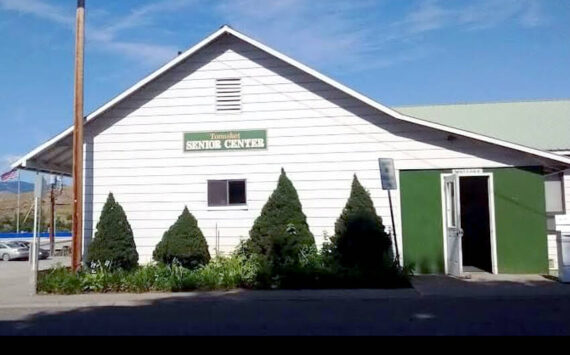Focus groups to formulate success, contingency plans
TONASKET – Citing the need to discuss “the elephant in the room,” North Valley Hospital District Administrator Linda Michel outlined a dual plan to cope with continuing financial losses at the North Valley Extended Care nursing home facility at the Thursday, Nov. 13, board of commissioners meeting.
The commissioners unanimously approved the recommendations formulated by Michel and the district’s senior administrators that formed a pair of teams: one, to find a way to make the nursing home financially viable; the other, to come up with a contingency plan to close the facility if the first team is unable to come up with such a plan.
The nursing home is projected to lose nearly $893,000 in 2014 and another $809,000 next year. The district, though it has climbed out of warrants and will finish 2014 about $1.2 million in the black this year and a projected $707,000 next year, is at risk if those losses continue, Michel said, thanks to rising costs and looming changes in how hospitals will be paid for Medicaid and Medicare patients, which comprise the majority of North Valley Hospital’s base.
Also, she said, the facility has more than $2 million in capital needs, including about $1.4 million in repairs and maintenance that she characterized as urgent but were not factored into the operations budget.
Those needs include equipment (cardiac monitoring system, patient lift, lab equipment, etc.) as well as facility needs (new windows in the Extended Care, roof and parapet on the older portion of the hospital, work on the HVAC system, and computer work to keep up with changing federal standards).
On top of that, the state has mandated that counties no longer loan hospital districts money to make up for shortfalls in daily operations – warrants – making the kind of debt that has sustained area hospitals over the past decade no longer an option.
“Just for next year we need $1.4 million in capital equipment to keep our buildings up and our staff safe,” Michel said. “… So we take our revenue for 2015 as a district, our $707,000 (profit) and (with those capital expenditures the district would be) $766,000 in the hole.”
Two focus groups
The two groups, Michel said, would work independently of one another.
The first will be tasked with identifying strategies, exploring those strategies and develop a plan for an extended care facility that is “financially viable.”
“When I say financially viable, I don’t mean that we make money or even break even,” Michel said. “But it’s got to be something that we can cover and cover easily. It has to be minimal loss.”
The other team’s task will be to develop a contingency plan.
“We have to have a contingency plan,” Michel said. “The other committee will algorithm out the steps for possible closure. We have to have that contingency plan. We can’t do it at the last minute.”
That team’s task will be to determine which actions must occur to carry out a closure.
“There are agencies we would need to contact, all kinds of things that have to be done,” Michel said. “We need to know what those steps are, just as a contingency plan.”
The teams each will be comprised of one elected commissioner; one member of the district’s administrative leadership team; two hospital district employees selected by the commissioner and administrative representative; and three community community members selected by the commissioner.
The recommendation accepted by the commissioners included Commissioner Teresa Hughes and Long Term Care Director Linda Holden assigned to the team targeting success strategies, and Commissioner Helen Casey and Chief Financial Officer Helen Verhasselt assigned to the closure contingency team.
The teams will provide updates at each board meeting beginning in December.
The teams have separate deadlines they must meet, but Michel said the deadline to determine a definitive action is March 27, 2015.
“By March we’ll know if they are going to raise our rates, and if we’ll be able to cover our losses,” she said.
“(If) we can’t cover bills and pay payroll, what do we do? I don’t wnat to stand up here with 230 employees and tell them they’re not getting a paycheck. What if the volumes are lower than predicted and we can’t cover the losses in extended care? We have to talk about that, folks. We have to get that out on the table. What if there are more Medicaid cuts? What if there’s an emergency like roof cave in? We have no emergency wiggle room.”
Background
At one time, nursing home facilities were profitable enough to support hospitals, as opposed to the other way around.
Michel said the Balanced Budget Act of 1997 brought about changes that eventually created the current situation that extends far beyond North Valley Hospital District.
“Under the pre-1997 rules the cost of ancillary services and capital related expenses were paid at 100 percent of cost and other services were paid at reasonable cost, which were healthy sums,” she said. “That required the implementation of a Prospective Payment Plan. … They no longer paid in accordance with the cost based system. They paid a per diem or daily rate and that covered all expenses … nursing services, routine costs, ancillary costs, capital related costs.”
“We had a substantial decrease in our reimbursement,” Michel said. “We’re not a private extended care. We are a public district. That means whoever knocks on our door gets in. We can’t differentiate between a Medicaid patient and private pay (through employer or self-purchased insurance). We must charge all patients the same rate.
Currently, the extended care bills each patient $243 per day. The cost of care currently averages $199 per patient per day, and Medicaid pays $149.98 per patient per day.
“We are not allowed by law to ask for any of that difference,” Michel said. “That’s fraud. I’m not ready for orange, and I don’t think the board is either. (That) leaves us about $49 per day per Medicaid resident that we cannot collect.
“The fact is if we only had one bed and one Medicaid resident we still would not come out even. That is just the fact. A higher volume won’t help because we’re still short per bed per day.”
She said the hospital receives reimbursements for Medicare patients, on the other hand, at a rate of $389 per day.
“But if we take that same short-term patient and put them in a swing bed in the hospital, Medicare pays us $1,721 per day,” she said. “That helps us support some of the loss in the extended care if we put them in a swing bed instead of in the extended care.”
Rising costs
In formulating the 2015 budget, Michel said that a number of factors contributed to the continuing rise in costs:
- the recently-concluded union negotiations added about $3 million in salary and benefit increases over the next three years (averaging about $1 million per year);
- Medicare is cutting its reimbursement rates by one percent both this year and next;
- reimbursement for bad debt is in the being reduced from 100 percent in 2012 to 67 percent in 2015;
- a switch over to value-based purchasing for Medicare that began this year, a transition that proceeds to 2019 (reimbursements become tied to readmission rates, cost of care, length of stay, and patient surveys);
- two pieces of legislation (House Bill 2572 and Senate Bill 6312) that will change how health care providers share information to better integrate the care of the whole person, as well as integrating mental health and substance abuse treatment more completely with the general health care system.
“It’s coming, we can’t change it. We have to go with it. We’re already working on it though it hasn’t been gone into effect yet…
“They believe this will be the best model for the patient as a whole, which I don’t disagree with. But they don’t know how they are going to do it. They are depending on us to tell them. They aren’t giving us guidelines, and it starts in 2015.”
She said the district needs to be prepared for those and additional changes coming over the next few years.
“The state estimates they will save more than $730 million in three to five years,” Michel said. “And that’s in their plan. They will move away from fee for service payment system, which is what we’re on.
… It will be a new era of Medicaid purchasing by 2016 … we’ll be paid for performance that rewards the quality we get.
“I’m not concerned about that (as NVH has had high quality ratings), except I got an email with quality measures and there are 53 of them.
“That takes a lot of manpower to report and track.”
Hospital reimbursements will be changed over to either global or bundled payments. With bundled payments, reimbursements will be paid based upon a patient’s initial diagnosis – if they patient later develops other problems, that care is at the hospital’s expense.
With global reimbursement, the hospital is paid a fee to cover its patient base for the entire year, meaning that at the end of the year the hospital could either have money left over at the end of the year, or end up paying for patient care on their own if the patient load is higher than anticipated.
With all that, Michel said that this year’s budget was the most difficult she had worked on in her 30-year career.
“We know as senior leaders and the board that our responsibility is to the communities we serve and the district as a whole,” she said. “We know that if we do not do something we’ll be in danger of losing what we have worked very hard to establish. We must act now.”







